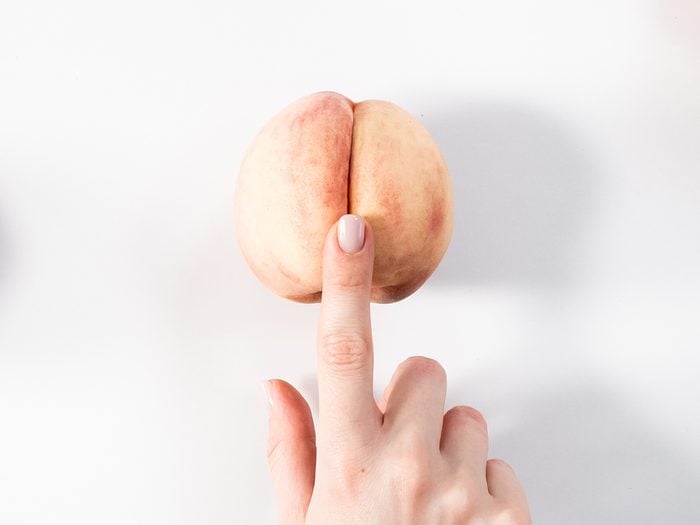Here’s What a G-Spot Is and How to Find It

Where is the G-spot? Many people say that stimulating this area in the vagina can lead to better orgasms. Here's how to find it.
You know the joke about the G-spot. Your partner couldn’t find it even with GPS coordinates. The G-spot is an erogenous zone said to exist on the anterior (closest to the belly button) wall of the vagina. Enthusiasts say that stimulating the G-spot leads to stronger, better, or more-intense orgasms, which may include “squirting” or female ejaculation.
Sounds pretty great right? But this may be easier said than done. For starters, experts aren’t sure that the G-spot exists as a distinct anatomical structure.
(Related: Samantha Bitty Knows Good Sex—and Wants You to Know It, Too)
Anatomy of the G-spot
The G-spot was first described in 1950 by a German gynecologist named Ernest Gräfenberg. That’s where it got its infamous name—the G stands for Gräfenberg, not “groin,” “go,” or “girl,” as is popularly thought.
In his paper, “The Role of Urethra in Female Orgasm,” originally published in the International Journal of Sexology, he describes all women as having a “highly erotic zone” about one inch past the opening of the vagina on the anterior vaginal wall and parallel to the urethra. He wrote that stimulation of that area causes intense sexual pleasure and contributes to orgasm, even saying that G-spot orgasms were superior to “regular” clitoral orgasms.
The spot is often described as feeling “firm,” “spongy,” or “bumpy” as compared to the surrounding tissue, and it’s said to be highly sensitive, similar to the clitoris. Some claim it swells or becomes erect when stimulated, similar to penile tissue.
The G-spot controversy
Since its first mention, the idea of a G-spot has really taken off, appearing in pop culture starting in the 1980s. A survey of about 1,100 North American women, published in the Journal of Sex & Marital Therapy in 1989, found that 84 percent believed that the G-spot existed. But less than 5 percent reported having a personal experience confirming its existence, and the vast majority said their belief was based on stories from friends or media.
Its existence as a structure in the female body has become a controversial topic, with professionals and laypeople alike speculating that it’s a physical, muscular, vascular, or neurological feature—or that it is pure fantasy.
(Related: Can Cannabis Help Kick-Start My Sex Drive?)
What the science says
Despite the many physical descriptions of it, no anatomical evidence of a G-spot was found in a 2017 study published in The Journal of Sexual Medicine. Scientists dissected the reproductive organs of 13 female cadavers, specifically looking for anything that might represent a G-spot on the anterior vaginal wall. After digitally mapping and physically examining the vaginas, they concluded that there is no anatomical structure other than the urethra. Nor is there any spongy or erectile tissue in the vaginal wall.
In short, the area of the vagina where the G-spot is said to be located appears to be no different anatomically than the rest of the vagina. However, many women do experience increased sensitivity in this area, even without any clear differences in the anatomy, according to a 2018 study published in the Journal of Clinical Sexology.
Researchers performed a manual vaginal examination on 800 women and found that 72 percent reported increased erotic feelings when that area on the anterior vaginal wall was stimulated as opposed to when other areas in the vagina were stimulated. To distinguish it from the problematic anatomical associations of the G-spot, they renamed it the “hypereroticism area.” This may not be as contradictory as it sounds.
Of the women who showed responsiveness in their “H area,” 68 percent also felt a strong urge to urinate, which may mean that the urethra—the one identified physical organ in that area—plays a part in sexual stimulation. It may also mean that “squirting” isn’t a separate vaginal fluid but rather urine.
The G-spot: A urethral sponge
Many people now believe that, anatomically speaking, the G-spot is the urethral sponge, says Sadie Allison, clinical sexologist and author of The Mystery of the Undercover Clitoris. “Every woman has a urethral sponge, a small, rigid, oval-ish area of spongy tissue that surrounds the urethral cord,” says Allison, who is also the founder of Tickle Kitty, a boutique that sells sex toys and lubricants. “It engorges with blood during excitement and intercourse to protect the woman’s delicate urinary passageway,” she says. However, it doesn’t seem to be there just for protection. “As it turns out, when stimulated, it can provide great sexual pleasure for some women,” Allison adds.
Your brain is your most important sex organ
When it comes to sexual satisfaction, believing that a G-spot is “real” can make a difference, according to a 2018 study in the Turkish Journal of Obstetrics and Gynecology. Researchers interviewed 309 sexually active women, ages 18 to 23, about whether they have a G-spot and how often they orgasmed. They found that the 50 percent of women who said they believe the G-spot exists reported less sexual dysfunction and more orgasms than the women who said they don’t think it is real.
Essentially, simply believing in a G-spot—or indeed having an area of increased sensitivity and pleasure—may increase your sexual satisfaction and improve your sex life.
(Related: What to Know About Sex Toys and 6 Inexpensive Options Worth Trying)
How to maximize your G-spot
Stimulating the area associated with the G-spot (or urethral sponge or H-area) can take sex and your orgasms to a whole new level, says Allison. Here are three tips for getting there:
Proper positioning
Ditch missionary position and try some other moves to hit the G-spot. Allison recommends “cowgirl,” or woman on top. “This is because she is in complete control of the speed, depth, positioning, and grinding and can tailor it all to exactly what she needs and gyrate herself to climax,” she says.
The toy aisle
There are many sex toys designed specifically to target the G-spot, often with two prongs (nicknamed rabbit vibrators) so you can stimulate the clitoris externally and the G-spot internally at the same time.
Finger play
The simplest way to find your G-spot is manually. You can do it with your own fingers or with a partner. Simply insert a clean finger into the vagina, palm up, and make a “come hither” stroking motion.
What to do if you can’t find your G-spot
It’s OK if you can’t find the area associated with the G-spot. There is no right or wrong way to orgasm. Whether you prefer sex alone or with a partner or partners, it’s important to do what works and feels best for you.




